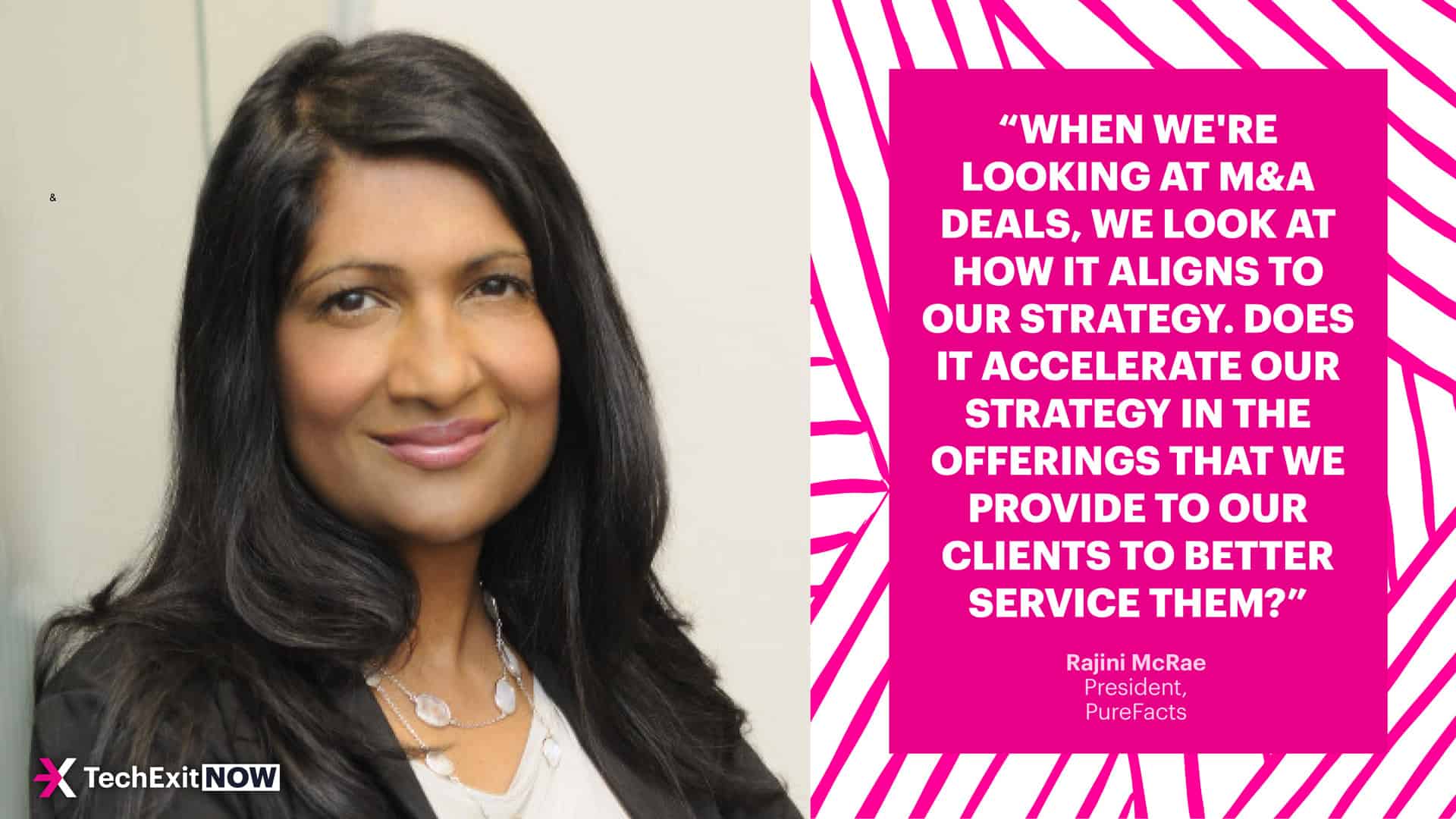How To Build a “Minimum Viable M&A Team” For Acquisition-Led Growth
Stefan Palios

Growing via acquisition is a wonderful, strategic move… but only if you have the right team behind you. Speaking with TechExit.io, business transformation leader Rajini McRae explained how to create a “minimum viable” M&A team in your startup.
Key takeaways:
- Not having the right team members can doom an acquisition to fail even if it otherwise is the right move.
- Don’t buy a company just for the sake of revenue—make sure it aligns with your overall company strategy.
- Cultural alignment is critical for acquisition success, particularly when buying founder-led companies.
Acquisition-led growth is exciting. But you want to make sure you’ve got the right skill sets to make it a success. Rajini McRae, the President of WealthTech company PureFacts, knows this world well. She has integrated multiple companies and helped Purefacts acquire small businesses over the years, working with Founder & CEO Rob Madej and Head Corporate Development & CFO, Gerard Daniels to do it. Speaking with TechExit.io, Rajini shared how to build a “minimum viable” M&A team to start your acquisition-led growth strategy.
Your minimum viable M&A team
If you’re just starting your M&A growth journey or don’t have a huge chunk of capital, that’s fine. But you still need the right team in place. If you can’t afford full-timers, here’s Rajini’s advice for what you need to cover your bases.
First, your essentials team needs to consist of:
Business leaders: this is the person leading the charge. They need to be thinking about client, cultural, and operational perspectives on the acquisition, understanding the overall “why” behind the purchase.
Lawyers: these are the people who will draft all documents making the acquisition legal. Don’t skimp out here.
Finance leaders: whether internal or a consultant, these folks will run the necessary financial models to understand both how the company will fit into your operational plans but also how the company could add to your growth.
Tech leaders: for tech M&A specifically, this person will handle the nitty-gritty of integration planning and tech due diligence.
The next team you need in place will depend on what the acquisition will provide for you.
If you’re buying a company to acquire a client roster, Rajini said you will need to ensure you have the talent to service those clients. If it’s solely about product, you’ll typically need the right people in place either for an integration, rip-and-replace, or possibly even a rebuild while still servicing customers. And if there are operational concerns, you’ll probably need to install shared services like HR or finance to create synergies.
“You need to understand why you're buying the company and what is the deal value that you're buying it for—and then you need to make sure you're retaining that and accelerating that,” said Rajini.
The strategy of acquisition
Before making any acquisitions, your team will need to answer two questions: first, is the current target acquisition the right acquisition? And second, how should you manage the company post-acquisition?
Pre-acquisition
Understanding if you have the right target, said Rajini, is a function of strategic alignment and cultural fit. The core of strategic alignment is acceleration—that is, will acquiring this company accelerate your company in some way? Typically, that’s through client acquisition & product acceleration. But occasionally, it’s for operational excellence, talent, or geographic expansion.
“When we're looking at M&A deals, we look at how it aligns to our strategy,” said Rajini. “Does it accelerate our strategy in the offerings that we provide to our clients to better service them?”
The second part of this equation is cultural fit. Or, more specifically, values alignment. Rajini explained that if a company doesn’t operate on the same values, you’re more likely to have issues post-acquisition. While this isn’t as much of a problem if you’re only buying raw technology but as soon as you are taking on employees, you’ll still want values alignment because that indicates how the company operated before you purchased it. For example, if you have a strong value on client intimacy and the target company values efficiency, then post-acquisition there will be potential challenges integrating the teams as differences in client service levels will be viewed differently. In these cases, it is essential to have a change management team to help with aligning the behaviours and ultimately the values.
Post-acquisition planning
If the business is the right fit strategically and culturally, your next question is about the operations of it all. Rajini said picking the right approach ultimately comes from how you service clients, your ‘target operating model.’
“We’ve become very regionally focused,” Rajini said, sharing an example of PureFacts’ evolving target operating model. “So our sales and distribution will be more regionally focused so we could service our clients faster and better and understand their needs more intimately.”
Rajini also said it depends on how you differentiate your company. If you’re product-led, for instance, you may have a product-focused operating model that prioritizes product integration, delivery, and R&D acceleration. As a result, prioritizing merging the company’s product offering first might make sense. Similarly, a customer-centric company might be open to a regional model to better serve its clients. On the flip side, an operations-centric company might pursue a centralized operating model that opens up better synergies and back-end cost savings.
Although companies have to manage and deliver on all elements of the business—client needs, operations efficiency and product solutions—the target operating model needs to ensure and enable the company’s unique differentiating experience.
“Determine how that particular acquisition is going to help service your market better because it's not buying for the sake of buying,” said Rajini.
BACK









